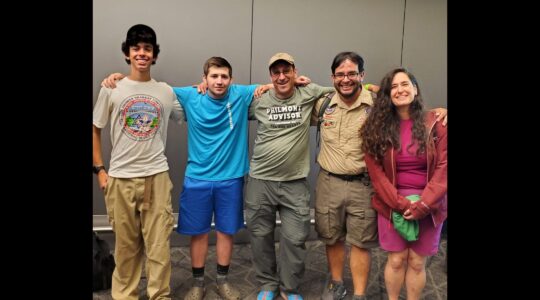NEW YORK, April 2 (JTA) A Jewish mother reacts to the news that her daughter has married a non- Jew: “My spirit was for some time so depressed that it was a pain for me to speak or see anyone. My house has been my prison ever since.”
Sound like a contemporary lament?
Perhaps, but these words come from colonial America in a letter written by Abigail Franks about her daughter’s marriage to a prominent French Huguenot.
The tale of Franks’ timeless worries is just one of many in a two-part documentary, “They Came For Good: A History of the Jews in the United States,” which will be aired on public television stations across the nation during the next few months.
The film traces the first 200-plus years of Jewish life in the New World from 1654 when 23 Brazilian Jewish refugees landed in Dutch New Amsterdam in what is present-day New York to 1880, the beginning of the massive Eastern European Jewish immigration.
Amram Nowak, the documentary’s producer and director, is currently at work on the next installments in his series, which will bring the story of U.S. Jewry to the present day.
The documentary which uses a mixture of scholars and actors speaking in the voices of historical characters frames American Jewish history as a struggle to maintain “identity while assimilating into a welcoming culture,” as narrator Mason Adams says at the beginning of the first part.
That idea stands as the framing device for the American Jewish experience, Nowak says, a tension that he believes has not been fully resolved.
“Will there be a Jewish community outside of the strictly Orthodox 50 years from now? It’s a big question that nobody can answer,” says Nowak, who made the film along with his wife, Manya Starr, who died before the project was completed.
Of course, the American Jewish experience is more complex than one of a struggle for preservation against assimilation. As the film itself makes clear, anti-Semitism also played a role.
New Amsterdam Lord Mayor Peter Stuyvesant initially refused those pioneering Jews whom he called a “deceitful race” that wanted “to infect” the colony permission to remain on the land until his superiors in Holland overruled him.
Even then, Jews had to care for their own sick and needy and were not at first allowed to own property.
The documentary highlights the Jewish experience in the major events in American history the Revolutionary War, the westward expansion and the Civil War.
The film’s strength stems from the fact that its story is told through the lives of individual Jews, both well and little known.
Most people have heard of Levi Strauss, the Jewish peddler who made a fortune during the Gold Rush by making riveted denim pants, and some may know about Haym Solomon, the Jewish financier who helped fund the Revolutionary War against the British.
Fewer probably have learned about Judah Benjamin, the Jew who served in the Confederate Cabinet during the Civil War, or Rebecca Gratz, the wealthy Philadelphia philanthropist who created the Hebrew Sunday School Society in the middle of the 19th century.
But those who know of Mordechai Noah, who established a rather unsuccessful Jewish colony in upstate New York in the 1820s, should count themselves among a chosen few.
Viewers will learn about more than just individual Jews, Nowak says. The entire story of pre-Eastern European immigration is one that is largely untold, he says.
Most people “think that Jewish history in America begins in 1880. Very few people are more than vaguely aware that there were Jews here 30 years after the Mayflower,” he says.
What will be new to many viewers was also new to Nowak. A yeshiva student as a child who grew up in a Zionist household in the Bronx, Nowak says he knew his Torah, but little about the early history of American Jewry.
For example, he knew little about the development of the Reform movement in the middle of the 19th century. And he was surprised to find that Sephardi Jews were the Jewish elite until the arrival of large numbers of German Jews in the 19th century.
“Sephardi was just a vague word to me,” he says.
Now, Nowak says, all that has changed.
“I got, if not my Ph.D., at least my master’s, in my five years of work on the project.”
JTA has documented Jewish history in real-time for over a century. Keep our journalism strong by joining us in supporting independent, award-winning reporting.





